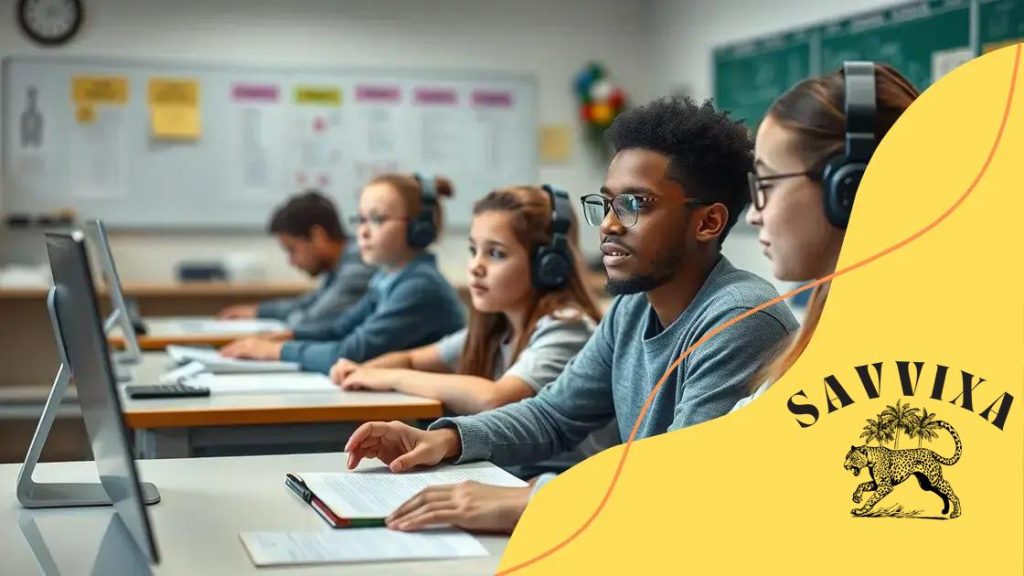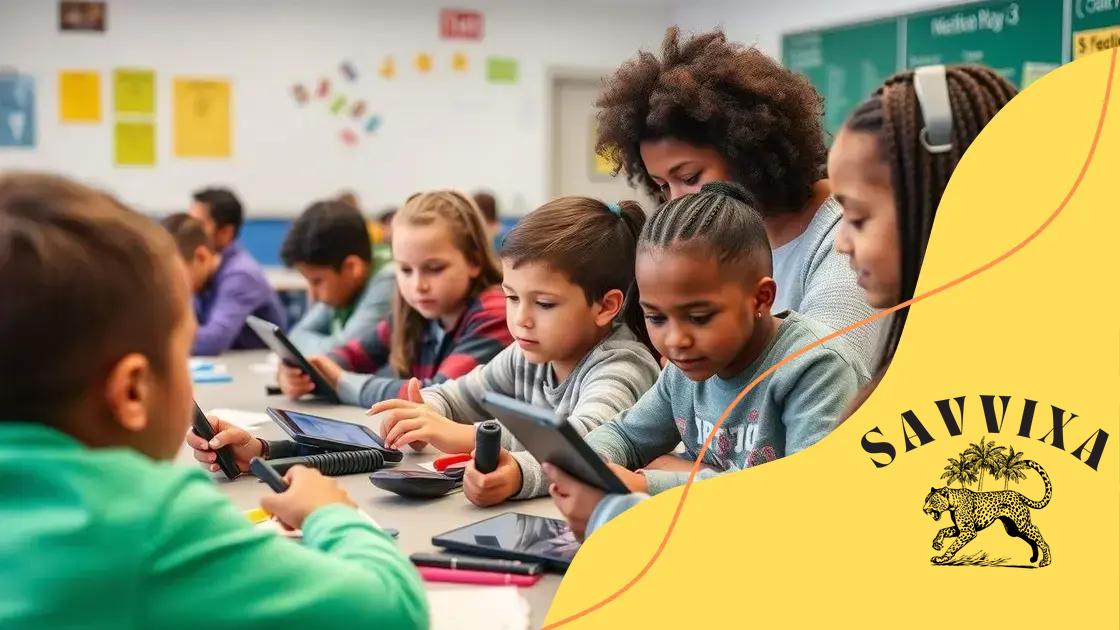Role of AI in special education: transforming learning

The role of AI in special education is to provide personalized learning experiences that cater to individual student needs, using technology to enhance engagement and support diverse learning challenges.
Role of AI in special education is reshaping how we approach learning for students with diverse needs. Have you ever wondered how technology could enhance their educational journey? Let’s explore the impact of AI on special education.
Understanding the needs of students with disabilities
Understanding the needs of students with disabilities is essential for creating an inclusive learning environment. Each student has unique challenges and strengths that need to be recognized and nurtured.
Identifying Different Types of Disabilities
To effectively support students, it is important to identify the various types of disabilities. These can include:
- Learning disabilities such as dyslexia and ADHD.
- Physical disabilities that limit mobility or require special equipment.
- Emotional and behavioral disorders affecting social interactions.
Recognizing these challenges allows educators to tailor teaching methods and support systems accordingly.
Creating a Supportive Learning Environment
To support students with disabilities, creating an accommodating environment is crucial. This can be achieved by:
- Providing assistive technologies that enhance learning.
- Implementing flexible teaching strategies that cater to diverse learning styles.
- Encouraging collaboration among students to foster peer support.
Strong communication between teachers, parents, and specialists can also help identify and address the needs of each student. It’s important to remember that every student can succeed when given the right tools and support.
By approaching education with empathy and awareness, educators can make a significant difference in the lives of students with disabilities. Tailoring instruction to meet these individual needs fosters a sense of belonging and promotes academic growth.
How AI personalizes learning experiences
AI is revolutionizing education by personalizing learning experiences for each student. This customization allows for tailored educational pathways that address individual strengths and weaknesses.
Understanding Personalized Learning
Personalized learning means adapting educational experiences to meet the specific needs of each student. This can include:
- Custom learning plans that focus on a student’s unique challenges and goals.
- Adaptive assessments that change based on a student’s performance.
- Real-time feedback to help students improve continuously.
With AI, educators can analyze data effectively to ensure that instructions are aligned with student needs.
AI Tools Enhancing Personalization
Several AI tools are available that can enhance personalized learning experiences. These tools offer:
- Learning management systems that allow customization of course materials.
- Virtual tutors that provide round-the-clock assistance.
- Data analytics features that help educators monitor progress.
Such technology empowers teachers to engage students in ways that were previously unthinkable. By using AI to adapt lessons, teachers can cater to learning styles that suit each individual.
Furthermore, the integration of AI facilitates a more inclusive classroom. Students who learn at a different pace or with different methods can thrive. Integrating technology in these ways means no student gets left behind.
As technology continues to advance, the possibilities for personalized education are expanding, offering new opportunities for both teachers and students.
Implementing assistive technologies in education

Implementing assistive technologies in education is essential for creating an inclusive and supportive learning atmosphere. These technologies help students with disabilities achieve their full potential.
Understanding Assistive Technology
Assistive technology refers to any device or software that aids students in their learning tasks. Some examples include:
- Speech-to-text software that helps students who have difficulty writing.
- Text-to-speech applications that assist students with reading challenges.
- Adaptive keyboards and mice that cater to those with physical disabilities.
Utilizing these tools can significantly impact a student’s learning experience and success.
Benefits of Assistive Technologies
Assistive technologies offer several benefits that enhance the learning experience. These include:
- Increased engagement and motivation in learning activities.
- Improved communication skills and expression.
- Greater independence in completing tasks.
These tools not only facilitate learning but also allow students to take ownership of their educational journey.
Integrating assistive technology into classroom practices can be transformative. Teachers need to be trained in how to effectively use these tools. This ensures that all students can benefit, regardless of their abilities. By providing access to various resources, educators empower students to overcome barriers and fully participate in the learning process.
As technology evolves, so do the opportunities for students with disabilities. Keeping up with the latest advancements ensures that educators can provide the best support possible.
Case studies of AI in special education
Case studies of AI in special education demonstrate how technology is changing the way students with disabilities learn. These real-world examples provide insight into the effectiveness of AI solutions.
Successful Implementations
Across various schools, AI tools have been successfully implemented to support learning. Examples include:
- Student A used speech recognition software to improve communication skills, resulting in increased participation in class discussions.
- Student B utilized customized learning apps that adapted to their pace, enhancing their understanding of complex subjects.
- Student C benefited from assistive reading tools that helped with comprehension and retention of information.
These cases highlight how AI can cater to different learning styles and needs.
Measurable Outcomes
Implementing AI in special education has led to measurable improvements. Schools tracked various outcomes, including:
- Increased test scores and academic performance.
- Improved social interactions and confidence among students.
- Higher rates of student engagement and motivation in learning.
These positive changes reflect the power of AI in transforming educational experiences.
Moreover, teachers involved in these initiatives reported greater satisfaction with their ability to tailor lessons and engage students effectively. By harnessing AI, they can better meet the diverse needs of their classrooms.
As these examples show, embracing technology in special education not only benefits students but also empowers educators to enhance their teaching practices.
Future trends in AI-assisted learning
Future trends in AI-assisted learning present exciting possibilities for education. As technology continues to evolve, so does the potential for individualized learning experiences that cater to each student’s needs.
Increased Use of Data Analytics
AI systems will increasingly use data analytics to analyze student performance. This helps educators understand learning patterns and make informed decisions.
- Predictive analytics can identify at-risk students early.
- Personalized learning paths can be developed based on real-time data.
- Customized interventions can be implemented quickly and effectively.
By leveraging these tools, educators can create a more supportive environment for every student.
Advancements in Natural Language Processing
Natural language processing (NLP) is set to transform how students interact with educational content. This can lead to:
- Virtual assistants that answer questions in real-time.
- Language translation tools that break down language barriers.
- Interactive dialogues that enhance learning through conversation.
Such advancements will make learning more engaging and accessible to a diverse range of students.
Moreover, we can expect more immersive learning experiences. AI technologies, like virtual reality (VR) and augmented reality (AR), will provide dynamic environments where students can practice real-world skills in a safe setting.
As these technologies develop, teachers will also adapt their methods. They can use AI tools to augment their teaching style, making lessons more interactive and tailored to student needs.
Overall, the future of AI-assisted learning promises a more inclusive and effective educational landscape for all students.
FAQ – Frequently Asked Questions about the Role of AI in Special Education
How does AI improve personalized learning for students with disabilities?
AI analyzes individual learning styles and needs, enabling tailored educational approaches that enhance student engagement and success.
What types of assistive technologies are commonly used in education?
Common assistive technologies include speech-to-text software, text-to-speech applications, and adaptive devices that cater to various learning challenges.
Can AI help teachers in managing diverse classrooms?
Yes, AI tools provide data-driven insights that help teachers understand student performance and adapt their teaching strategies accordingly.
What are some future trends in AI-assisted learning?
Future trends include increased use of data analytics, advancements in natural language processing, and the integration of virtual and augmented reality for immersive learning experiences.